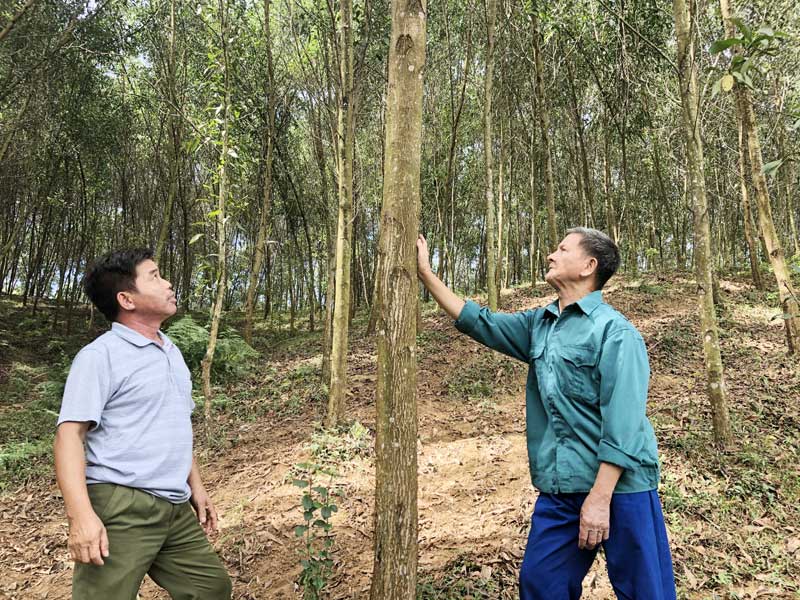
(HBO) – In 2016, the agriculture extension centre of Hoa Binh province launched a project on developing a model for synchronously applying technical advances to planting fast-growing large-timber forests. This project covered 38ha of land with 20 households participating. After four years of implementation, up to 95-98 percent of the trees planted under this project have survived with even growth, height of 10-12m and trunks 15-20cm in diameter.
 Bui
Van Danh (right), a resident in Bin hamlet of Tu Ne commune (Tan Lac district),
shares experience in planting fast-growing large-timber forests with other
locals.
Bui
Van Danh (right), a resident in Bin hamlet of Tu Ne commune (Tan Lac district),
shares experience in planting fast-growing large-timber forests with other
locals.
Planting large-timber forests is useful for
saving seedling and care-related expenses while improving economic efficiency
on a same area of cultivation (large-timber forests generate value three-four
times higher than that of small-timber ones) and minimising pests and diseases
on trees as well as land degradation.
To carry out the project in Tan Lac, the
provincial agriculture extension centre provided seedlings for local
households. The chosen varieties are BV10, BV16 and BV32 of Acacia hybrid.
Tan Lac district boasts huge potential for
forestry development. The district has zoned more than 33,300ha of land for
forestry, including over 25,000ha already under forest.
However, locals have yet to fully capitalise on
the forestry development potential but just exploited young and small trees for
raw materials and wood chips. Besides, their cultivation practices are out of
date and mainly focus on extensive farming, instead of intensive farming and
improving forest productivity and quality.
Basing on the provincial agriculture and rural
development’s policy of converting small-timber forests into large-timber ones
for more profit, authorities of Tan Lac have boosted communications to
encourage people to adopt growing large-timber forests while sending staff from
the district’s agricultural services centre and agriculture extension workers
of local communes to monitor forest development.
As a result, local residents have gradually
realised the importance of the intensive farming of large-timber forests and
changed their practices. After nearly four years of project implementation,
though the planted trees haven’t matured enough for exploitation, experts and
locals said they have seen initial encouraging outcomes in planting
fast-growing large-timber forests and believe that the practice will become
profitable and help protect the environment./.
More than just an information technology teacher, Bui Van Nien is an inspiring figure who has nurtured the scientific curiosity and creative spirit of students in Vietnam’s ethnic minority communities.
Da Bac is the most disadvantaged mountainous district in Hoa Binh province, with ethnic minorities accounting for about 90% of its population. Over the past years, the district has mobilised resources to implement ethnic policies to improve the quality of life of local people.
In recent years, Hoa Binh province has consistently prioritised the protection, care, and education of children, particularly those from ethnic minorities and disadvantaged backgrounds, by creating a safe, healthy, and nurturing environment for their all-round development.
The Steering Committee for Tobacco Harm Prevention and Control of Hoa Binh province, in coordination with the Tobacco Harm Prevention and Control Fund, held a ceremony on May 28 in response to the World No Tobacco Day (May 31) and the National No Tobacco Week (from May 25 to 31). The event was chaired by Nguyen Van Toan, Standing Vice Chairman of the provincial People’s Committee and head of the Steering Committee.
Since 2021, the Center for Industrial Promotion and Industrial Development Consulting (CIIDC) under the Department of Industry and Trade has been implementing a school lighting model as part of the plan for using energy efficiently and economically in Hoa Binh Province in the pẻiod of 2021 - 2025. This model not only aims to improve the learning conditions and enhance the education quality, but it also promotes the message of energy saving, energy security, environmental protection and contributes to the goals of socio-economic development.
In the 2024 - 2025 school year, the entire Hoa Binh provincial education sector includes 520 educational institutions and schools. Among them are 13 ethnic boarding schools with 153 classes and 4,487 students. Four of these schools have met national standards, reaching 30.7 percent.



 Bui
Van Danh (right), a resident in Bin hamlet of Tu Ne commune (Tan Lac district),
shares experience in planting fast-growing large-timber forests with other
locals.
Bui
Van Danh (right), a resident in Bin hamlet of Tu Ne commune (Tan Lac district),
shares experience in planting fast-growing large-timber forests with other
locals.